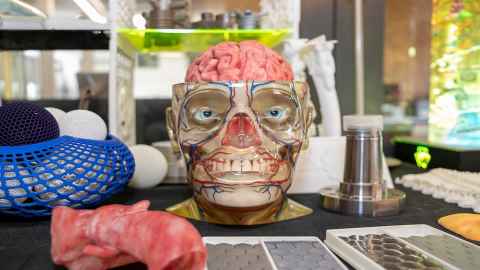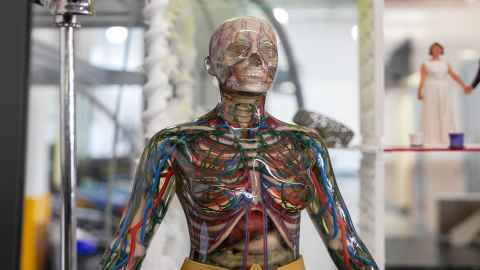Creative Design and Additive Manufacturing Lab wins Engineering New Zealand's engineering creativity award
19 July 2021
The team's 3D printed anatomical models can help surgeons plan unique approaches for their patients.

Imagine a team of surgeons sitting around a table with a 3D printed spine as centrepiece. It has artificial bones, organs, and muscles around it. There’s a tumour at the base of the spine, and the surgeons need to figure out how to remove the tumour without damaging the surrounding body parts.
They might point to the model or pick it up. They could rotate it. They could trace their pens through the model, creating a path to the tumour like the submarine in The Fantastic Voyage. But where they once would’ve had to pour over MRIs, CT scans, and grainy X-Rays to solve this surgical problem, the medical experts can now examine it in three dimensions.
This is a practical example of the project for which the University of Auckland’s Creative Design and Additive Manufacturing Lab (CDAM Lab), or 3D printing lab, won Engineering NZ’s 2021 Award for Engineering Creativity. The team’s project, “Life in plastic, it’s fantastic: 3D printed anatomical models” uses clear and coloured material to reproduce anatomical models in stunning detail, with every bone, organ, and vein visible. Surgeons can use these models to plan unique approaches for each individual patient.

The winning team members are Prof. Olaf Diegel, Dr Juan Schutte, R&D engineer Simon Chan, and Research Operations Coordinator Claire Barnsley. Diegel, the Lab’s director, said the initial idea that spawned the notion to make plastic organs followed the Lab’s creation of a highly complex Beatles-themed bass guitar. The guitar was 3D printed in white material and had to be hand-painted in excruciating detail. “My wife had to go in with a fine paint brush, and hand-paint all the lettering [on the guitar], which was basically a royal pain,” Diegel said. “It was… because of this guitar that we started trying to print in full colour, just to see if it could be done.”
The team decided to use their colour printer to create anatomical models after seeing other labs across the world experiment with similar projects. They started by creating a large transparent human body, which Diegel affectionately refers to as the “anatomically correct Barbie doll.” They then spoke with people at Auckland District Health Board and moved on to more complex projects. One of these is a large plastic artery with a stent in it, that doctors can use as a teaching tool. “Doctors always tell patients ‘we’re going to put a stent in you’ and the patients have no clue what it means,” Diegel said. The team created a fist-sized educational model so doctors could show their patients instead.
Subsequently, a doctor came to the Lab with a request. They have a patient with a tumour that sits alongside the spine and is surrounded by other organs. The tumour is in a dangerous spot and necessitates intricate surgery. The surgeon wants a 3D printed model of the tumour’s location so their surgical team can figure out how best to remove it. The CDAM Lab is working to reconcile data from CT scans and MRIs to create a true-to-life model of the tumour so the doctors can figure out how to do that.

The Lab is also working on creating bone models for medical students to practice drilling on, and bioprinting heart valves, and more. Nathaniel McTaggart, a Biomedical 3D printing Design Engineer and Clinical Engineer at Auckland District Health Board, is excited about the possibilities. “By collaborating with the CDAM Lab, we can now better leverage 3D printing technologies that we otherwise couldn’t,” McTaggart said. “This opens up a wide range of medical applications.”
Professor Julian Paton, Director of Manaaki Mānawa (the Centre for Heart Research in Auckland) and co-Director of the new Centre of Research Excellence, Healthy Hearts for Aotearoa New Zealand (HHANZ), is also excited by 3D printing’s possibilities. “Sophisticated 3D printing that uses different materials… can improve medical treatment for cardiovascular disease,” he writes.
Ultimately, Diegel would like to print soft material so doctors can physically practice virtual surgeries before performing them on any patient. He also wants to make a 3D printed body that medical students can “pull apart like a doll” to expose and view the different organs. Eventually, he hopes for Auckland Hospital to be able to create 3D printed models for surgical planning in-house.
The team also wants more people to be aware of 3D printing technology and how to apply it. “There’s word-of-mouth knowledge that this Lab exists,” Claire Barnsley said. “The more the word gets out, the more there’s scope for the application of creative additive manufacturing.”